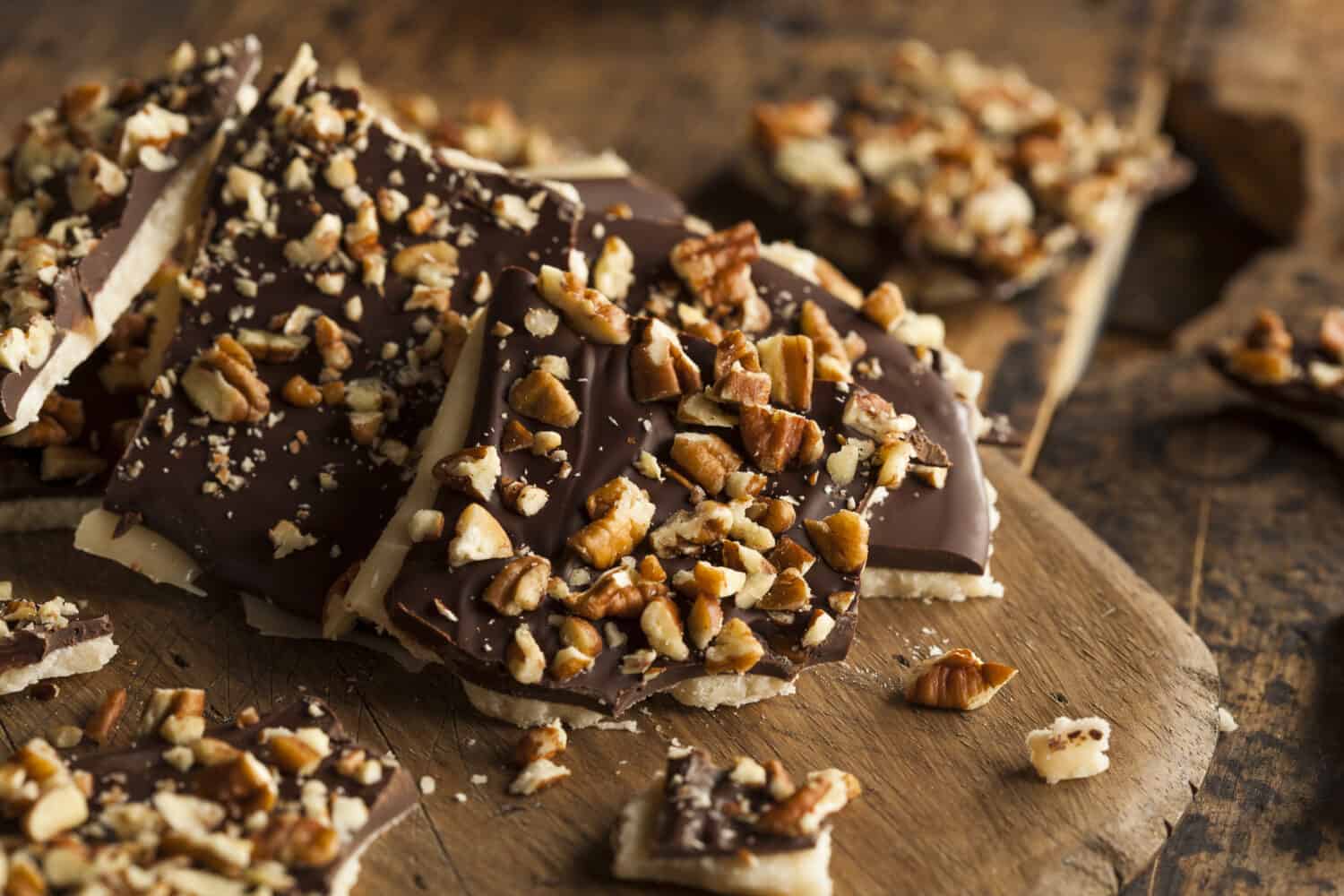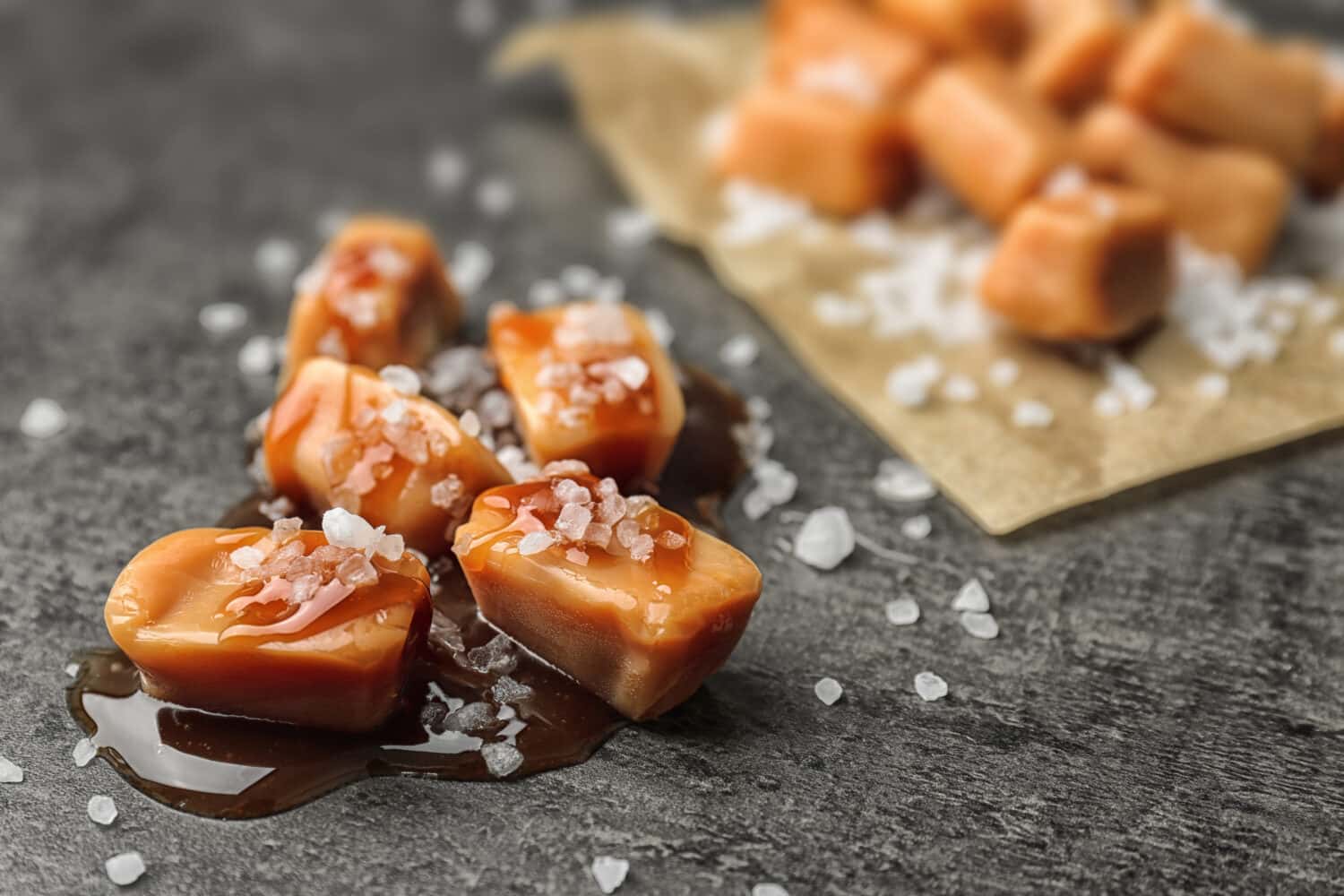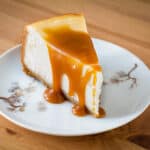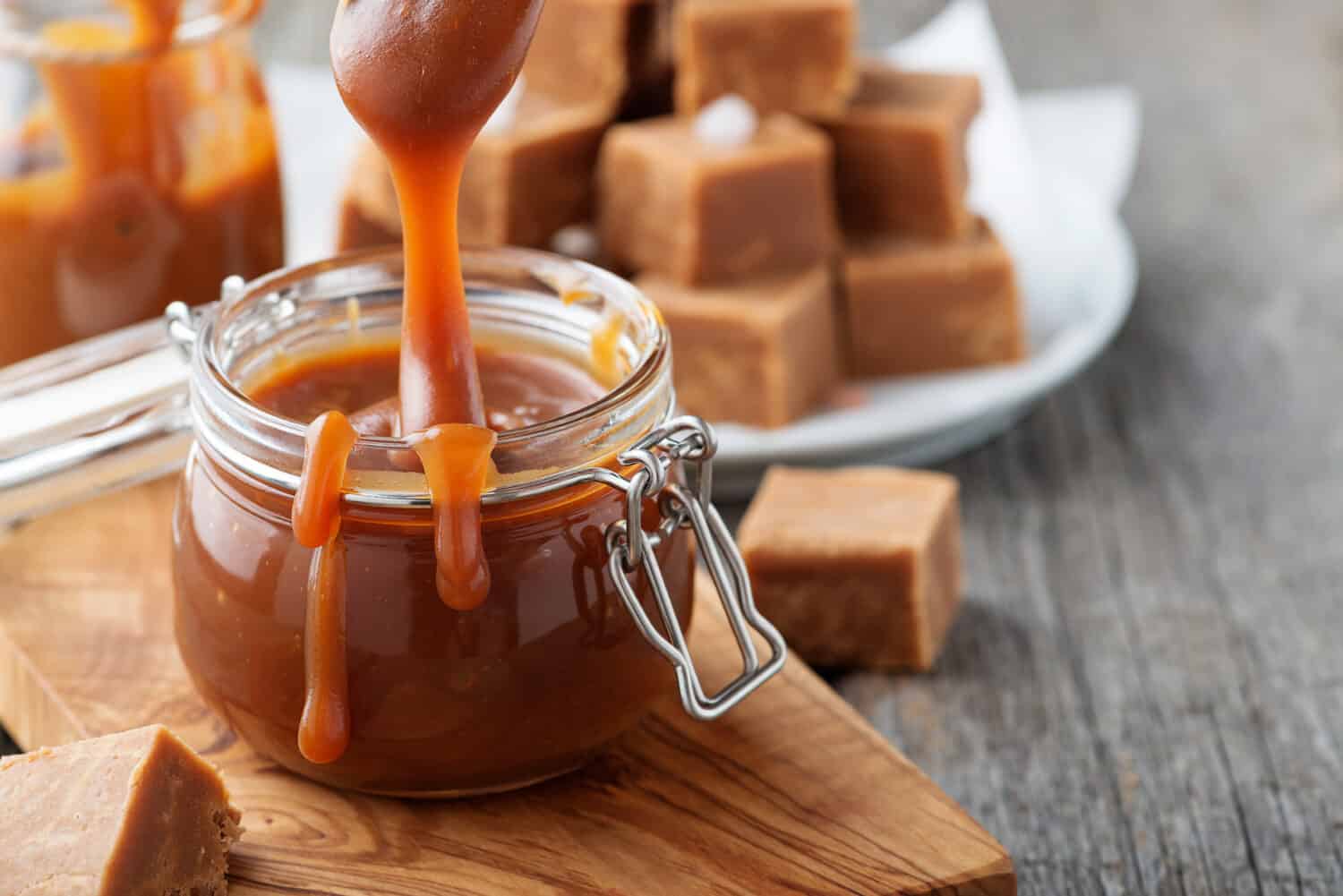People often interchange the words toffee and caramel due to their similar appearance. While both are sugar treats that may look alike, toffee and caramel have distinct differences. Toffee and caramel differ in taste and texture due to their ingredients and the temperatures used to create them. Although both candies are delicious on their own, chefs often incorporate them into desserts such as pies, cakes, and puddings. We will examine the four main differences between these delicious treats and also note which one is the healthier choice.
Toffee vs. Caramel: What Is Toffee?
Toffee is a hard, sweet candy with a buttery texture. It is crispy at first but quickly melts in your mouth, providing a rich, smooth, and satisfying experience. Brown sugar adds a rich flavor similar to caramel. To add more texture to the toffee, mix nuts and chocolate into the confection. If you like hard and crunchy sweets, then toffee fits the bill.
The word toffee first appeared in the Oxford English Dictionary in 1825. Historians think toffee became a popular treat soon after sugar and butter became abundant. They also believe English toffee, sometimes called “buttercrunch,” originated in Wales.
While English coffee commonly uses pure cane sugar, molasses, and brown sugar, American toffee uses granulated white sugar or corn syrup. English toffee almost always has chocolate, while American toffee typically uses a variety of nuts.
How Toffee Is Made
English and American cooks may use different ingredients while making toffee, but the basic recipe remains the same. Toffee is prepared by combining butter, sugar, and water in a saucepan. The mixture is heated and stirred continuously until it turns golden brown, which is a result of caramelization. It is important to keep stirring to prevent the toffee from burning. Before pouring toffee into a tray to cool, cooks often add toppings such as nuts or chocolate. Once the toffee hardens, it is broken into jagged pieces or squares.

©Brent Hofacker/Shutterstock.com
Toffee vs Caramel: What Is Caramel?
To make caramel, cooks heat sugar until it melts and turns an orangish-brown color. The longer cooks heat up the sugar, the darker and thicker the caramel becomes. Light caramel, often used as a glaze, requires less heat and has a mild, sweet flavor akin to plain old sugar.
Caramel cooked to a medium stage has a sweet, nutty flavor and people commonly use it as a topping, in candies, and for making caramel apples. Ice creams and cakes often use the highest-heated caramel for its thicker consistency and slightly more bitter taste.
Historians believe caramel dates back to the 11th century, when the Arabs created “kurat al milh” – sweet balls of salt. These caramel balls were harder to chew than the modern version of carmel. However, contemporary caramel, used in candy, desserts, nougat, and ice cream, has its foundation in this early version of caramel.
As the abundance of sugar and milk increased around 1850, people created a softer and chewier caramel by adding milk and fat. In 1886, Milton Hershey established his first candy company, the Lancaster Caramel Company. Hershey's version of caramel soon spread all over America and then Europe. As a result, Hershey's version of caramel helped establish this confection as one of our favorite candies and toppings.
How Is Caramel Made?
When sugar is heated until it caramelizes, it becomes caramel. (Caramelization is simply the process of converting sugar into caramel.) At around 320 degrees Fahrenheit, the sugar starts to melt and form a liquid. When the temperature reaches 340-350 degrees Fahrenheit, the sugar begins to bubble and forms filaments. Adding butter and cream when the sugar is between 365-395 degrees Fahrenheit can create sweet candies and caramel sauce.
In 1977, French pastry chef Henri Le Roux created salted caramel. It took the chef three months to perfect his caramel mixture that incorporates almonds, hazelnuts, and walnuts. That year, salted caramel won France's best confection competition and eventually became popular throughout the world.
Toffee vs Caramel: 4 Key Differences
Now that we understand what toffee and caramel are, here is a table comparing the top four main differences between these sweet treats. Toffee and caramel differ in their flavor, ingredients, cooking temperatures, and uses.
| Toffee | Caramel | |
|---|---|---|
| Flavor | Toffee has a rich, sweet, and buttery flavor. It is initially hard, but quickly melts in your mouth. | The taste of caramel ranges from slightly sweet to a deep, nutty flavor. |
| Ingredients | Toffee is made with sugar and butter, although some recipes may include additional ingredients like molasses or corn syrup. | Caramel is made by heating sugar, often with butter; the added cream gives caramel a smooth and creamy texture. |
| Temperature | To reach the toffee's hard, brittle texture, cook it until it reaches 310 degrees Fahrenheit. The toffee will have rough and jagged fragments when done. | Cook caramel sauce to 225-230 degrees Fahrenheit. A dry caramel will require even higher temperatures. |
| Uses | Toffee may be used as a topping or a treat enjoyed on its own. Some cooks add nuts or chocolate to toffee. | Caramel appears in candy, cakes, and puddings. It is often used as a dessert topping. |
Toffee Vs Caramel: Which One Is Healthier?
So, you might be wondering which one is better for you – toffee or caramel? Let's be real; neither of them is exactly healthy, but we all know they're just too delicious to resist! So, which one is the better choice?
Caramel is less healthy than toffee because it has a lot of calories due to the butter, cream, or condensed milk used to make it. And, obviously, it has a lot of sugar. Moreover, we typically drizzle caramel on pies, ice cream, or cakes, adding to the sugar content. All of this sugar is bad for your overall health. It can also contribute to tooth decay.
However, toffee is hard and chewy, so it may be difficult to eat for those with dental problems. The good news is that toffee is slightly better for you than caramel because it usually contains only sugar and butter. Furthermore, toffee has less sugar than caramel. So, if health considerations are a concern, toffee is the marginally healthier choice.

©New Africa/Shutterstock.com
Final Thoughts
Toffee and caramel may seem alike, but there are four significant differences between them: their flavors, ingredients, cooking temperatures, and uses. Toffee has a hard and brittle texture that quickly melts in your mouth. English and American variations of toffee exist, and people can enjoy them either as standalone treats or as toppings.
Caramel has a soft and chewy texture that people can enjoy on their own or use as toppings in custards, pies, and cakes. Due to the presence of butter, sugar, and cream, caramels contain more sugar and calories. However, you can still include both caramel and toffee in a well-balanced and healthy diet. Just eat them in moderation.
Recipe Card
Looking for a delicious sweet treat that will wow your friends and family? We have the perfect recipe for you.
Print
Butterscotch Caramel Cheesecake
Ingredients
Crust:
- 1 and 3/4 cups graham cracker crumbs, finely crushed
- 1/3 cup butter, melted
- 1/4 cup granulated sugar
- 1/4 cup pecans, finely chopped
Filling:
- 11 oz Nestle Toll House Butterscotch-Flavored Morsels
- 14 oz Nestle Carnation Sweetened Condensed Milk
- 4 packages (8 oz each) cream cheese, softened
- 1/2 cup granulated sugar
- 1/4 cup all-purpose flour
- 2 teaspoons vanilla extract
- 4 large eggs, slightly beaten
- 1/4 cup caramel ice cream topping
- Whipped cream
Instructions
- Preheat oven to 325 degrees Fahrenheit. Wrap the outside bottom and side of a 9-inch springform pan with a double layer of heavy-duty foil.
- Combine graham cracker crumbs, butter, granulated sugar, and nuts in a medium bowl. Press the crumb mixture onto the bottom and 1 inch up the side of the prepared pan.
- Remove 2 tablespoons of butterscotch morsels and set aside for garnish.
- Heat milk and remaining morsels in a medium saucepan over low heat until morsels are melted, and the mixture is smooth; remove from heat. Cool to room temperature.
- Beat cream cheese, granulated sugar, flour, and vanilla extract in a large mixer bowl until combined. Add butterscotch mixture; beat until smooth.
- Add eggs and beat just until combined. Pour into prepared pan.
- Place pan in large roasting pan; fill roasting pan with warm water halfway up the side of springform pan.
- Bake for an hour and a half or until a two-and-a-half-inch area around the outside edge appears set when gently shaken. Carefully remove the cheesecake from the water.
- Pull the foil away from the pan and lift the springform pan out of the foil to the wire rack. Cool on a wire rack for 15 minutes.
- Run a knife around the edge of the cheesecake. Cover and refrigerate for 6 hours or overnight.
- Remove the side of the pan. Spread caramel topping over top of cheesecake. Pipe the outer edge of the cheesecake with whipped topping. Garnish with reserved morsels, if desired.
The image featured at the top of this post is ©nelea33/Shutterstock.com.


